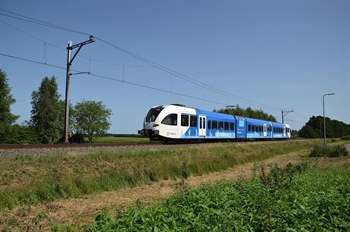Case study Improving the Zwolle-Emmen public transport link
In recent years, the Zwolle-Emmen route has been greatly improved. Capacity has been increased by the use of faster trains and by adding carriages to three trains. The aim was to bring the chance of passengers getting a seat on this route back within the norm.
The public transport link between Zwolle and Emmen has been improved by various measures in recent years. Tailor-made agreements have been made with educational institutions, efforts have been made to avoid rush-hour journeys in public transport, and rolling stock has been used differently.
The frequency of trains on the Zwolle-Emmen link was increased in 2012 because the new provider started to deploy faster trains. This allowed more trains to run on the mostly single-track section, which meant more frequent trains for travellers.
In addition, in 2015 three trains were extended with the addition of extra carriages, increasing the capacity of the trains. Thanks to the partnership with Optimising Use, this measure with extra carriages was financed 50-50. A total of €6.1 million was invested in the three carriages. This investment included, for example, purchase, transfer of management, and maintenance costs.
Implementation
The objective of improving the Zwolle-Emmen public transport link was to enable passengers to travel in a pleasant way. To this end, the provincial authorities wanted to create extra capacity and, by doing so, to bring the chance of getting a seat back within the norm. The 'default' norm is that 5% of passengers may stand for a maximum of one station. This norm was not achieved, particularly in the rush-hour periods.
A general penalty clause of €250,000 per month was included for failure to meet the norm. In practice, it is very difficult to impose this fine because it is not possible to clearly identify the reason why the norm was not met. That is why it was decided to develop the train service jointly. The provinces of Overijssel and Drenthe drew up a development vision for the railway link. This vision comprises an interrelated package of measures that influence demand, as well as measures relating to rolling stock and infrastructure.
For this project, ProRail, the transport company Arriva, and the provinces of Overijssel and Drenthe are working together in a unique way. The parties take part in tripartite meetings and can therefore make quick and clear agreements. There is also rapid insight into whether or not certain measures are possible.
In this case, the provinces are responsible for revenue.
This also means that the provinces receive the income from passengers deriving from measures that the provinces implement. The parties therefore have to discuss together in order to arrive at good solutions. In the case of the Zwolle-Emmen route, there is great satisfaction with the successful partnership.
As stated earlier, there is a correlation between capacity expansion on this route and taking measures to try to influence travel behaviour. There has been attention for other forms of mobility, for the behaviour of, for instance, students, and there has also been a rush-hour avoidance pilot project with the MyOV app. You can find more information about this in the Rush-hour avoidance on public transport case study.
Results
The results of improving the public transport link are highly dependent on external factors that may influence train use. Examples include autonomous growth, the relocation of an important branch of a major company, and students in secondary vocational education (mbo students) who have also been issued with a public transport card.
The 'Decentralised Rail' effect measurement by the Ministry of Infrastructure and Water Management shows that the three extra carriages on the Coevorden-Zwolle route add 153 extra seats to the three busiest journeys on that route. The evaluation shows that the combined package of measures on this line has led to a 59% reduction in perceived inconvenience (due to overcrowding) and that there are 29 additional passengers travelling on this line every day.
General rules of thumb on the effectiveness of improving, for example, the journey time or comfort on public transport links can be found in the fact sheet Improving public transport links.
Considerations for deployment elsewhere
Improvement of a public transport link is not always the solution to the problem. On the Zwolle-Emmen route, the student public transport card for mbo students, for example, ensured that demand was given an extra boost. The changing nature of the problem is, therefore, a point for attention. Deployment of a completely new train may take two years, but at that point the capacity problems might have been resolved or, on the other hand, become three times worse. Even for the duration of the permit, there must still be attention for short-term problems with capacity. One solution may be measures to control demand, or tweaks to optimise the service.
One positive aspect that the project has revealed is the way in which partnership has been achieved. As all the parties are continuously in negotiations, there is more integrated consultation. The provincial authority is better aware of where there are potential problems, and helps to devise solutions. And those are sometimes outside the transport provider's sphere of influence. Moreover, this form of partnership radiates a shared vision.
Another recommendation is to take a pragmatic approach to measures. Take a practical look at what is possible in terms of expanding capacity and try it out, where appropriate and possible. For instance, on the Zwolle-Emmen line testing involving checking that longer trains were not too long for the existing platforms was carried out at night. This appeared to be a problem in theory, but it was shown to be feasible after all in practice.

